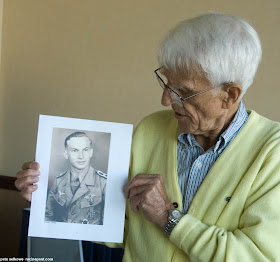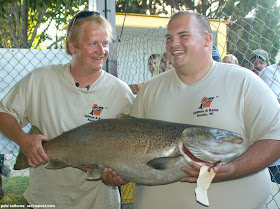
Robert Goebel, describing his air battles during WWII
There are no schools, streets or statues in Racine named for Robert Goebel.
Which is somewhat surprising, given that the Racine native downed 11 German airplanes in World War II. Pilots with just five kills became "aces." Or the fact that he's a member of the Wisconsin Aviatin Hall of Fame, holder of the Distinguished Flying Cross with one oak leaf cluster, the Air Medal, with 17 oak leaf clusters, and a Silver Star for gallantry in action.
"I did what I had to do," Goebel said this weekend, home for a family reunion at St. John Nepomuk Catholic Church celebrating the 75th anniversary of his older brother, Norbert, now deceased, and his wife, Lucille. Norbert would have been 100 this week. On Sunday afternoon, the family gathered at the Radisson Harborwalk where "Uncle Bob" talked for an hour about his WWII exploits.
He was just 19, a graduate of St. Catherine's High School, when he enlisted in the Air Force. (Before the attack on Pearl Harbor you needed two years of college for that.) He made it through three stages of flying school, six months in Panama guarding the canal, to North Africa and then through 61 missions over southern Europe, escorting bombers in the "Flying Dutchman," his P51 Mustang fighting off German Messerschmitts.
Air battles are very different today than they were in his day, Goebel says. Today many battles are fought by drones, controlled by pilots safely thousands of miles away. For another: "The guy in the back seat says, 'I fired the missile,' and the pilot says, 'Well, did we get them?' and the guy in the back says, 'I don't know; it was 10 miles away."
In Goebel's day, air combat was up close, "eyeball to eyeball," he says. "You could see the other pilot turning and looking at you in the cockpit." He rarely fired the six machineguns on his Mustang from more than 150 to 300 yards from his target ... and once his plane was sprayed with glycol and fuel from the airplane he hit, he was that close to it.
Goebel described the air battle he fought on Aug. 18, 1944 -- the day he brought down not one, not two, but three German fighters. "Fighters were getting scarce," he said, but on this day he led an "extra" flight of four Mustangs escorting B17s on a bombing run against industrial targets over Ploiești, Rumania. The extra Mustangs meant "we could get into whatever mischief we could find," Goebel said.
He described two of his kills like this: "I thought I saw some little dots flying very fast to the east, but I lost sight of them on the Russian side of Ploiești. I was kind of doping off, not paying much attention." But suddenly, "The sky was full of Messerschmitt 109s. It was kind of like Keystone Cops: 'Are those...???' "
Goebel said he turned his Mustang into the 109s, "to give them the most difficult shot. They had two to three times the number we had; if they got to six o'clock behind us, we're dead. I cut loose my first burst (of machinegun fire). There were flashes all over him. I got a two-second burst into him and he came right out of his airplane."
"I spotted another 109 and went after him. I was going very fast; the P51 was very fast in a dive. I got some strikes. We were down to 8,000 ft. His canopy came off and he came out. His parachute never opened. I watched him fall into a plowed field. It was not a pretty sight."
By now, Goebel was all alone; he'd lost his wingman and the other Mustangs flying with him. "I couldn't raise anyone on the radio. I was 600 miles from base. "It was pretty lonely." He gained altitude to 20,000 feet, where he felt safe. "But I was alone, in a very vulnerable position. Every 15 seconds I looked all around. I had just checked, when 'BAM!!' here come two 109s, and the three of us got into it, going round and round.
"They were hesitant," he says. "I think they were low on fuel." The Messerschmitts headed north; Goebel was headed west. "They seemed glad to leave me... well, not me! Good judgment is not found in 21-year-old pilots. I was low on ammo, in a bad position. Maybe I was a little hasty," Goebel says, describing how he "pressed in and began firing at the 109s," until one crashed.
"It was a very lonely feeling, eerie. It was dead quiet on the radio; my flying suit was drenched with sweat. I'm kind of a basket case. I'm studying my gas gauges all the way back, running on fumes." When he finally landed, his crew chief couldn't find a single bullet hole in his Mustang; it must have been engine detonation that warned him of the last two 109s, not tracers. "I had God flying with me in that plane that day," he says.

Sixty years later, when Goebel decided to write a book about his exploits, he felt a compulsion to learn something about the pilot who had ejected only to fall straight down into the plowed field. He tracked down a Belgian historian who had researched German fighter pilots and learned that there were only two fighter wings flying out of Ploiești that day, and just one airman -- Herbert Franke, pictured at right -- who died in that manner. Goebel contacted Franke's friend by letter. "It was not an easy letter to write: 'I killed your friend...' " but they met in 1996 at a meeting of German Luftwaffe pilots and became friends. The German pilot told him, "Those were the days when we were all young and beautiful. Today, we are just beautiful."

Goebel also described the air battle he had with German ace Erich Hartmann -- who had more than 300 kills, mostly of Russian planes early in the war. Goebel won that battle, but it's not clear whether he shot down Hartmann or whether the German's plane just ran out of gas. In either case, the German pilot bailed out -- and while he was parachuting down Goebel "flicked his armament switch to the camera-only position. He tracked the enemy pilot, depressed the trigger to activate his gun camera, and was rewarded with proof of his victory," according to FlightJournal magazine, which had the story on its cover, with an illustration of Goebel, right. Goebel flew close to the descending pilot, "raising his hand in a chivalrous gesture," before flying home. Goebel only discovered for sure who that pilot was when he compared his account of the incident to one in Hartmann's own memoir.
From FlightJournal.com
Asked Sunday about the pilot's code of honor, Goebel said the German pilot "thought he was going to be shot out of his parachute harness. Of course, I would never do that. In our group, I never saw it, and don't know anyone who did it. You fight a guy tooth and nail; once it's done, it's over." In the foreward to his book, "
Mustang Ace: Memoirs of a P51 Fighter Pilot," Goebel writes, "Like the rest of my generation, in combat I did what I had to do the best way I knew how. There was no hating, no anguish, no sense of guilt. Only an attitude of getting the job done. Since those days, I have met many ex-Luftwaffe pilots, men who were worthy adversaries. I listened as they dispassionately described the downing of an American bomber or fighter. I have concluded that their attitude, then and now, was very much like my own. "
Goebel,who is 87 today, got out of the Air Force in 1946 and returned to Wisconsin for college. After college he re-enlisted, finally retiring in 1966, and then worked in the space program. "
Mustang Ace," is available at Amazon.com.
























